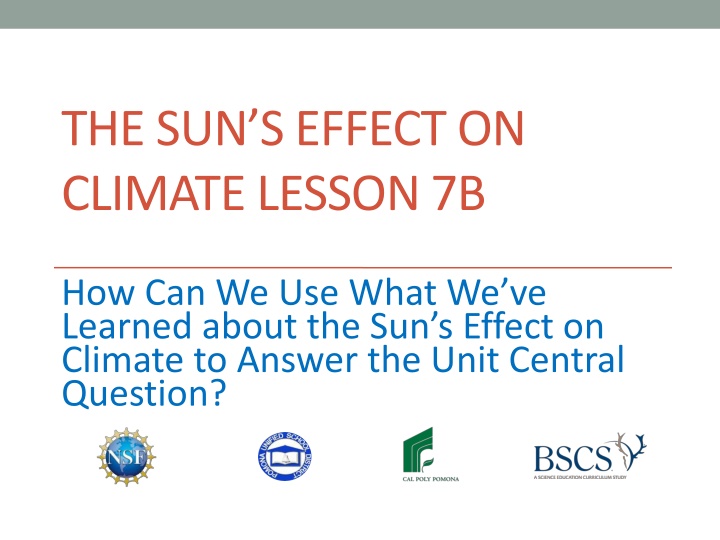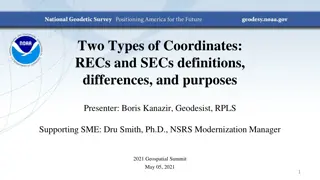
Understanding the Sun's Impact on Earth's Climate
Explore how the Sun's effect on climate can help answer why different places on Earth experience varying temperatures throughout the year. Team presentations and challenges focus on applying key scientific concepts to address the central question. Engage in discussions and share explanations to enhance understanding.
Download Presentation

Please find below an Image/Link to download the presentation.
The content on the website is provided AS IS for your information and personal use only. It may not be sold, licensed, or shared on other websites without obtaining consent from the author. If you encounter any issues during the download, it is possible that the publisher has removed the file from their server.
You are allowed to download the files provided on this website for personal or commercial use, subject to the condition that they are used lawfully. All files are the property of their respective owners.
The content on the website is provided AS IS for your information and personal use only. It may not be sold, licensed, or shared on other websites without obtaining consent from the author.
E N D
Presentation Transcript
THE SUNS EFFECT ON CLIMATE LESSON 7B How Can We Use What We ve Learned about the Sun s Effect on Climate to Answer the Unit Central Question?
Team Presentations As your team presents ideas and explanations for your assigned challenge today, it s very important that you apply key science ideas from previous lessons! This will show how much you ve learned and make sure we come up with the best answer for our unit central question!
Our Unit Central Question Why are some places on Earth hotter than others at different times of the year?
Lesson Focus Question How can we use what we ve learned about the Sun s effect on climate to answer the unit central question? By using everything you ve learned about the Sun s effect on climate, you ll be able to answer this question and the unit central question at the same time!
Team Challenges: Final Presentations Before we begin our presentations, meet with your team. Review your team s explanation for your assigned challenge, including any drawings. Decide whether one team member will present your team s explanation or everyone will share something. If you have diagrams or drawings you want to share, please let me know so I can display them.
Team Challenges: Final Presentations We ll begin the presentations with Challenge 1 and continue in order through Challenge 4. Listen carefully without interrupting as each team presents their ideas, explanations, and evidence. Think about whether you agree or disagree with an explanation, have a question to ask or an idea to add, or have evidence to challenge an idea. After each presentation, you ll have an opportunity to share your comments and questions. Make sure to communicate like a scientist!
Team Challenge 1 Why do Big Bear Lake, Santa Monica, and Pomona have different average temperatures throughout the year, even though they re close to one another? What is your explanation? What is your evidence?
Team Challenge 2 How might you explain the temperature pattern in Bel m, Brazil? What is your explanation? What is your evidence?
Team Challenge 3 Why do Santa Rosa, Argentina, and Richmond, Virginia, experience opposite temperatures (warm versus cold) at different times of the year? What is your explanation? What is your evidence?
Team Challenge 4 Why is it warmer in the summer than in the winter? What is your explanation? What is your evidence?
Lets Summarize! Key science idea for Challenge 1: While latitude is the key factor that influences regional climates, elevation and being close to large bodies of water can also cause temperature differences at the same latitude.
Lets Summarize! Key science idea for Challenge 2: Sunlight is more direct or concentrated near the equator throughout Earth s orbit around the Sun. That s why temperatures are warmer all year long in places that are close to the equator.
Lets Summarize! Key science idea for Challenge 3: The curved surface of Earth and its consistent tilt as it orbits the Sun cause the angle and intensity of sunlight hitting Earth at different latitudes to vary according to the time of year. These factors produce seasonal temperature differences in the Northern and Southern Hemispheres.
Lets Summarize! Key science idea for Challenge 4: Earth s consistent tilt changes the angle of sunlight hitting the surface during Earth s orbit around the Sun. Summers are warmer because one of Earth s hemispheres is tilted toward the Sun, and the angle of sunlight hitting the surface is more direct and intense. Winters are colder because one of Earth s hemispheres is tilted away from the Sun, and the angle of sunlight hitting the surface is less direct and intense.
Our Unit Central Question Why are some places on Earth hotter than others at different times of the year? Look over the science ideas you wrote in your science notebook during this unit. Based on everything you ve learned, how would you answer the unit central question now? Think about two parts of this question: 1. Why are some places hotter than others in general? 2. Why are some places hotter at different times of the year?
Our Unit Central Question Why are some places on Earth hotter than others at different times of the year? Share your ideas for answering this question with a partner. Using key science ideas from all of the lessons, write your bestanswer to this question in your science notebook. Be prepared to share your ideas and evidence with the class.
Looking Ahead In this unit, we explored how the Sun s energy heats Earth unevenly. In future lessons, you ll learn about daily weather patterns. Climate describes conditions on Earth over long periods of time like years or decades. Weather describes conditions on Earth over short periods of time like hours or days. Understanding climate and temperature patterns in different locations will make it easier to understand and predict weather patterns on Earth in future lessons.






















